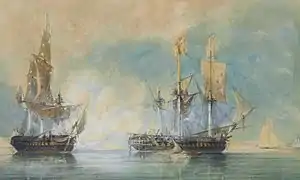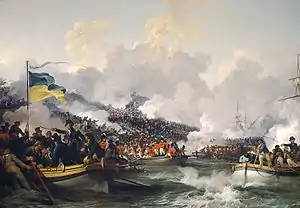HMS Romulus (1785)
HMS Romulus was a 36-gun fifth rate frigate of the Royal Navy. At the outbreak of the French Revolutionary Wars, Romulus was despatched to the Mediterranean where she became part of the fleet under Lord Hood, initially blockading, and later occupying, the port of Toulon. She played an active role during the withdrawal in December, providing covering fire while HMS Robust and HMS Leviathan removed allied troops from the waterfront.
 a Flora-class frigate, similar to Romulus | |
| History | |
|---|---|
| Name: | HMS Romulus |
| Ordered: | 28 December 1781 |
| Builder: | Greaves and Purnell, Limehouse |
| Laid down: | November 1782 |
| Launched: | 21 September 1785 |
| Fate: | Broken up, 1816 |
| General characteristics [1] | |
| Class and type: | Flora-class |
| Tons burthen: | 87937⁄94 (bm) |
| Length: | 137 ft 2 in (41.81 m) (gundeck) |
| Beam: | 38 ft 3 in (11.66 m) |
| Draught: | 9 ft 5 1⁄2 in (2.883 m) to 13 ft 6 1⁄2 in (4.128 m) |
| Depth of hold: | 13 ft 3 1⁄2 in (4.051 m) |
| Propulsion: | Sails |
| Sail plan: | Full-rigged ship |
| Complement: | 270 |
| Armament: |
|
With three other frigates and 13 ships-of-the-line, Romulus chased a smaller French fleet into Gourjean Bay in August 1794. Kept away by the batteries on the shore, Hood returned to Corsica with four ships, leaving Romulus and the remainder to form a blockade. This ultimately failed due to bad weather and the French ships escaped. Following an action on 14 March 1795, boats from Romulus assisted in the rescue of stores and crew from HMS Illustrious, which had been badly damaged during the battle and subsequent storm.
In January 1797, Romulus was in the small squadron, under Commodore Horatio Nelson that evacuated the island of Elba. While the escaping convoy was escorted to Gibraltar, Romulus, with Nelson's ship Minerve, carried out a surveillance of the enemy ports and coast. On 24 May 1797, in a ruse de guerre, she captured a Spanish 20-gun corvette. Sneaking up under false colours with another British frigate, the Spanish vessel was taken without a shot being fired.
She was converted to a troopship in mid-1799 and served in the Navy's Egyptian campaign, landing troops at Aboukir bay on 8 March 1801. She paid off at the end of the war in 1802. When hostilities resumed, Romulus was converted into a floating battery, standing guard first at Woolwich, then Hollesley Bay near East Anglia and finally Leith. During the later half of 1810, Romulus was converted to a troopship once more and in 1812 was back in the Mediterranean. In July 1813 she had a short-lived appointment as a hospital ship in Bermuda. She paid off that December, was recommissioned a final time, and was finally broken up on the island in November 1816.
Construction and armament

Romulus was a 36-gun, Flora-class frigate built to John Williams' design and ordered on 28 December 1781. Her keel, of 113 feet 0 inches (34.4 m) was laid down at Limehouse in November 1782 by shipwright company Greaves and Purnell.[2] The build cost £11,154 5/4d.[1]
When launched on 21 September 1785, Romulus was 137 feet 2 inches (41.8 m) along the gun deck, had a beam of 38 feet 3 inches (11.7 m) and a depth in the hold of 13 feet 3 1⁄2 inches (4.1 m). She was 87937⁄94 tons burthen and drew between 9 ft 5 1⁄2 in (2.883 m) and 13 ft 6 1⁄2 in (4.128 m). When fully manned, she carried a complement of 270.[1]
Flora-class frigates were initially designed to carry a main battery of twenty-six 18-pounder (8.2 kg) guns, with a secondary armament of ten 6-pounder (2.7 kg) guns on the upperworks. By the time Romulus was ordered however, the armament had twice been increased with the addition of eight 18-pounder carronades and twelve 1⁄2-pounder (0.23 kg) swivel guns in September 1799 and the upgrading of the 6-pound long guns with 9-pounders in April 1780.[2]
Service
Launched on 21 September 1785, Romulus was taken down the Thames to Deptford Dockyard. Work began on 11 October to have her sheathed in copper and rigged for sailing to Portsmouth. The works cost £1,736.[1] With a further £2,333 spent finishing the fitting-out at Portsmouth, Romulus had cost the Admiralty £15,345 5/4d
Between May 1790 and September 1791, Romulus was under the command of Thomas Lennox Frederick after which she paid off. Following Britain's entry into the French Revolutionary War in February 1793, Romulus was recommissioned under Captain John Sutton and refitted at Portsmouth in April. On the twenty-second of that month she set sail for the Mediterranean where she joined Admiral William Hotham's squadron.[1]
In August she was blockading the port of Toulon with Samuel Lord Hood's fleet and was among the vessels that shared in the capture, on 5 August 1793, of the Prince Royal of Sweden[3] She took a polacca on 20 August, while in the company of Agamemnon, Robust and Romney and on 28 August she took part in the occupation of Toulon, receiving a share of the prize money for the ships captured there.[4] With HMS Meleager, she captured a French gunboat on 16 November[5] and during the evacuation in December, Romulus provided covering fire while HMS Robust and HMS Leviathan removed allied troops from the waterfront.[6]
Corsica
Early in 1794 Romulus, with HMS Victory, Fortitude, Egmont, Princess Royal, Alcide, Captain, St George, Imperieuse, Juno, Aurora and Meleager, supported the troops under Sir David Dundas that captured the town of San Fiorenzo in the Gulf of St Florent, Corsica. There they found the scuttled French frigate Minerve on 19 February 1794, and were able to refloat her. She was taken into service as the 38-gun St Fiorenzo. Romulus shared in the prize money for both the frigate and for the naval stores captured in the town.[7]
The British fleet under Samuel Lord Hood was laying off Bastia in early August 1794 when word was received that seven French ships-of-the-line and five frigates had broken out of Toulon. Setting off in pursuit, with 13 ships-of-the-line and four frigates, including Romulus, the British spotted their quarry on 10 August, and by dawn the next day had closed the distance to 12 nautical miles (22 km). Wishing to avoid conflict with a superior force, the French sought shelter in Gourjean Bay.[8] When they arrived at the anchorage at about 14:00, the only British ship close enough to engage was the frigate Dido which was beaten off by the fire from the rearmost French vessels and the two forts guarding the entrance. A plan was formulated to capture or destroy the French fleet with Romulus, Dido, Juno, Meleager and the 74-gun HMS Illustrious, attacking the four enemy frigates. The scheme was delayed by contrary winds and tides and then cancelled after the French fortified their position by landing guns and establishing batteries on the shore.[9]
Hood returned to Corsica with Victory, the 98-gun Princess Royal and two 74s, leaving the remainder of the fleet under Hotham. This force, comprising nine ships-of-the-line and four frigates, including Romulus was supposed to blockade the bay, but was blown off station during a storm, and the French escaped back to Toulon.[9]
Battle of Genoa
Later that August, George Hope became the captain of Romulus, and in November Hood left for England, leaving Hotham as the Commander-in-Chief.[1][9] Romulus was one of seven frigates which, together with 13 ships-of-the-line, two sloops and a cutter, were anchored in the roads of Livorno on 8 March 1795. The following day, a British scout, the 24-gun sloop Moselle, brought news that a French fleet of 15 ships-of-the-line, six frigates and two brigs, had been seen off the islands of Sainte-Marguerite.[10] Hotham immediately ordered his ships to sea and on 10 March the advanced British frigates spotted the French fleet at some distance. Making their way back to Toulon against the wind, the French had with them the recently captured Berwick, which had been undergoing repairs at Corsica when taken.[11]
The British had been in pursuit for two days when on the night of 12 March a storm developed. Two French ships of the line, Berwick and Mercure, were damaged and had to be escorted to Gourjean Bay by two frigates, leaving the opposing fleets roughly equal in strength and number. Seeing that the French were intending to avoid battle, the next morning Hotham, who had hitherto been trying to form line, ordered a general chase, and at 08:00 the 80-gun Ça Ira at the rear of the French fleet, collided with Victoire and its fore and main topmasts collapsed overboard.[12] The leading British ship was the 36-gun frigate, HMS Inconstant under Captain Thomas Fremantle, which reached the damaged Ça Ira within an hour of the collision and opened fire at close range, causing further damage. Seeing the danger, the French frigate Vestale fired upon Inconstant from a distance before taking the limping Ça Ira in tow.[13]
The chase continued throughout the day and night with the British van sporadically engaging with the French rearguard. Ça Ira dropped further and further behind the main body of the French force; to better protect the damaged ship, Vestale was replaced with the ship of the line Censeur.[14] By morning the fleets were 21 nautical miles (39 km) southwest of Genoa with the British rapidly gaining on the French. Ça Ira and Censeur had fallen a long way back from the French fleet, and Hotham sent his two fastest ships after them. Captain and Bedford did not arrive simultaneously however, and were both repulsed, although further damage was inflicted on the French stragglers in the process. As more British ships arrived, the French fleet broke off the engagement and left Ça Ira and Censeur to their fate. Hotham was content with the capture of these prizes and made no attempt to pursue the fleeing French.[15]
After the action, the British fleet anchored in the Gulf of La Spezia to make repairs, but on 17 March was struck by a heavy gale. The badly damaged HMS Illustrious, which had been taken in tow by HMS Meleager, broke free and grounded near Avenza.[16] On 20 March, the weather had abated sufficiently to effect a rescue. Romulus, Tarleton, Lowestoffe, and teams of ship's boats, successfully removed all of the crew and most of the ship's stores without casualties but were unable to save the irreparably damaged ship. Once the wreck had been cleared, it was set on fire and abandoned.[17]
Following temporary repairs, Romulus and her compatriots left the bay on 25 March and arrived the next day at San-Fiorenzo where further work was carried out to the battle and storm damaged British fleet. Upon completion on 18 April, Hotham's ships, minus the two prizes, Ça Ira and Censeur, set sail for Livorno and anchored in the roads there on 27 April.[17]
Escort duties and cruising
On 26 September, in company with HMS Diadem, Romulus captured an enemy ship, Aballata, loaded with specie.[18] She took another prize in January the following year, and a further vessel in July 1796.[19] Romulus was also in sight when HMS Lively captured the Danish ship, Concordia on 27 February 1796, and was therefore entitled to a share of the spoils.[20]
In January 1797, Romulus assisted in the evacuation of the island of Elba along with Minerve under Commodore Nelson, the frigates, Dido and Southampton; the storeships Dromedary and Dolphin, and two sloops. On 29 January the squadron left Portoferraio, with 12 transports bound for Gibraltar but on that evening, Minerve and Romulus left the convoy to carry out a surveillance of the enemy ports and coast.[21] The two frigates travelled first to Corsica, evacuated by the British in October the previous year. Finding nothing of any consequence in San Fiorenzo Bay, Nelson decided to investigate Toulon. Arriving on 1 February, two days were spent in the roads and looking into the port but there was no sign of the enemy fleet, and the few ships that were there were not in a seaworthy condition. The squadron subsequently sailed to Barcelona, where they flew French colours in the hope of tempting out any ships within. This ruse de guerre was not successful however, and with the wind being contrary for Minorca, the two British vessels sailed instead for Cartagena. Finding it empty also, Nelson surmised that the combined Spanish and French fleet had gone west and was operating outside the Mediterranean. Minerve and Romulus therefore, rejoined the rest of the squadron at Gibraltar on 10 February.[21][22]
With the 36-gun, 12 pound frigate HMS Mahonesa, Romulus captured the 20-gun Nuestra Senora del Rosario off Cadiz on 24 May 1797.[23] The two British ships approached under false colours and did not reveal their true identity until they were alongside; at which point the Spanish corvette struck, without a shot being fired.[24] Romulus and Mahonesa made a further capture on 10 September when, this time with the assistance of HMS Thalia, they took the French brig, Espoir.[25][26] In February 1798, Romulus sailed for England, under Sir Henry Heathcote, where she paid off.[27]
Later service and fate

During mid-1799, Romulus was recommissioned as a troopship and sent to the Mediterranean.[27] Even in this lightly-armed state she was still an effective warship, capturing a Danish brig out of Livorno on 14 June 1800.[28] On 30 September 1800, Romulus was in sight when a privateer took a Swedish brig, and was therefore entitled to a share of the prize money.[29] She served in the Navy's Egyptian campaign, landing troops at Aboukir bay on 8 March 1801, where she came under fire, which killed one of her crew and wounded another.[30] She paid off at the end of the war in 1802. When hostilities resumed, Romulus was converted into a floating battery, with thirty-two 18lb long guns, eight on the upperworks. She guarded the Thames near Woolwich until June, when she was transferred to Hollesley Bay, off East Anglia, a popular anchorage for the Royal Navy at that time. In May 1804, she was moved to the Firth of Forth where she stood sentry near Leith.[27]
Romulus was laid up at Chatham from 1807 until some point in 1809. Between June and October 1810 she was converted to a lightly-armed troopship with fourteen 9-pounders on the upper deck, two on the forecastle and six 18-pound carronades on the quarter deck. In 1812, she was serving in this capacity in the Mediterranean, then in July 1813 she was used as a hospital ship in Bermuda. This was a short-lived appointment, and she paid off in December. She was later recommissioned but, eventually broken up on the island in November 1816.[27]
External links
 Media related to HMS Romulus (ship, 1785) at Wikimedia Commons
Media related to HMS Romulus (ship, 1785) at Wikimedia Commons
Citations
- Winfield (2007) p. 205
- Winfield (2007) pp. 204–205
- "No. 13982". The London Gazette. 21 February 1797. p. 184.
- "No. 15807". The London Gazette. 14 May 1805. p. 655.
- "No. 13911". The London Gazette. 12 July 1796. p. 676.
- Ireland p. 281
- "No. 14026". The London Gazette. 8 July 1797. p. 646.
- James (Vol. I) pp. 192–193
- James (Vol.I) p. 193
- James (Vol.I) pp. 256–257
- James (Vol.I) p. 256
- "No. 13766". The London Gazette. 7 April 1795. p. 305.
- James (Vol.I) p. 257
- James (Vol.I) p. 258
- James (Vol.I) pp.258–259
- James (Vol.I) p. 264
- James (Vol.I) p.265
- "No. 15449". The London Gazette. 30 January 1802. p. 106.
- "No. 15553". The London Gazette. 25 January 1803. p. 118.
- "No. 15587". The London Gazette. 24 May 1803. p. 628.
- James (Vol.I) p. 366
- Mahan p. 260
- Winfield (2008) pp.211-212
- "No. 14023". The London Gazette. 27 June 1797. p. 615.
- "No. 15320". The London Gazette. 16 December 1800. p. 1416.
- "No. 15300". The London Gazette. 7 October 1800. p. 1161.
- Winfield (2008) p. 136
- "No. 15278". The London Gazette. 22 July 1800. p. 844.
- "No. 15720". The London Gazette. 17 July 1804. p. 878.
- "No. 15362". The London Gazette. 5 May 1801. p. 497.
References
- Gregory, Desmond (1985). The Ungovernable Rock: A History of the Anglo-Corsican Kingdom and its role in Britain's Mediterranean Strategy During the Revolutionary War (1793–1797). London & Toronto: Associated University Presses. ISBN 978-0-8386-3225-3.
- Ireland, Bernard (2005). The Fall of Toulon: The Last Opportunity to Defeat the French Revolution. Cassell. ISBN 978-0-304-36726-9.
- Winfield, Rif (2007). British Warships in the Age of Sail 1714–1792: Design, Construction, Careers and Fates. Seaforth Publishing. ISBN 978-1-84415-700-6.
- Winfield, Rif (2008). British Warships in the Age of Sail 1793–1817: Design, Construction, Careers and Fates. London: Seaforth. ISBN 978-1-86176-246-7.
- James, William (1837) [1827]. The Naval History of Great Britain, Volume I, 1793–1796. London: Richard Bentley. OCLC 634321885.
- Mahan, A. T. (1897). The Life of Nelson – The Embodiment of the Sea Power of Great Britain (Volume 1). London: Sampson, Low, Marston & Co.
